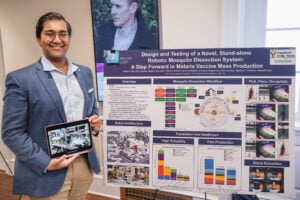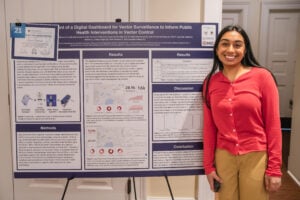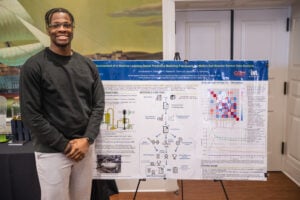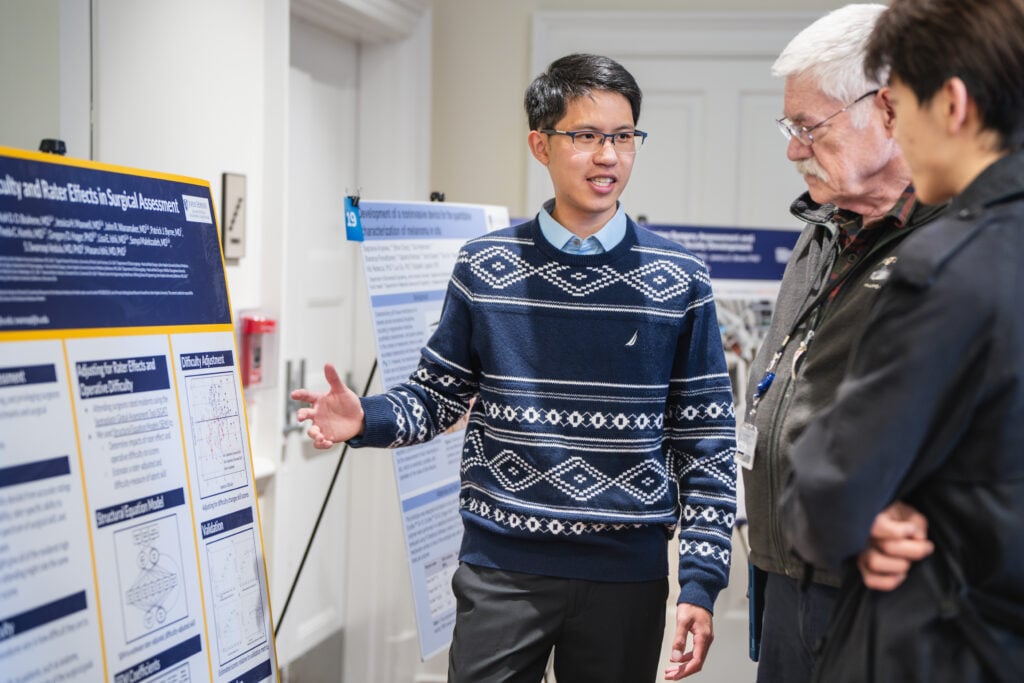The Malone Center hosted its rescheduled 2024 symposium poster session in Shriver Hall on January 30. As part of the 8th Annual Johns Hopkins Research Symposium on Engineering in Healthcare, “From the Research Lab to the Market: The Science of Translation in Healthcare,” the event featured the latest in healthcare engineering research. The 25 presenters received a certification of participation, while the top three posters as voted by session attendees received Amazon gift cards.

Aabhas Jain and poster.
Aabhas Jain, a graduate student in the Laboratory for Computational Sensing and Robotics, won first place with his poster, “Design and Testing of a Novel, Stand-Alone Robotic Mosquito Dissection System: A Step Forward in Malaria Vaccine Mass Production.”
Mentored and supervised by John C. Malone Professor of Computer Science Russell H. Taylor, Jain worked alongside Mohit Gupta, Engr ’24 (MSE); Balázs P. Vágvölgyi, an associate research engineer at LCSR; Simon Leonard, an assistant research professor in the Department of Computer Science; Iulian Iordachita, a research professor in the Department of Mechanical Engineering; and Sanaria Inc.’s Sumana Chakravarty, Kim Lee Sim, and Stephen Hoffmann to develop a robotic system for automated mosquito salivary gland extraction with the ultimate goal of eradicating malaria.
Malaria remains a critical global health threat, with both mortality and case numbers rising annually, but permanent solutions to eradicate the disease through vaccination are hindered by large-scale production challenges, as current vaccine production techniques depend on the labor-intensive and time-consuming process of manually extracting mosquito salivary glands. Jain’s team developed and evaluated a new, mobile, stand-alone extraction system that represents a substantial improvement in reliability and throughput over previous systems; the team’s findings represent an important step toward scalable malaria vaccine production by translating earlier research into an initial industrial-level solution that supports global eradication efforts.

Shreya Raman and poster.
The second-place prize went to Shreya Raman—an undergraduate student double majoring in computer science and biology who is affiliated with the Center for Bioengineering Innovation and Design—for her presentation, “Development of a Digital Dashboard for Vector Surveillance to Inform Public Health Interventions in Vector Control.”
Her team—including Soumyadipta Acharya, her research mentor and an assistant professor of biomedical engineering; CBID’s Marina Rincon Torroella, Sunny M. Patel, and Aryaman Shodhan; undergraduate student Christina Heal-Kowal; graduate students Parthvi Mehta and Atul Antony Zacharias; Neil F. Lobo, a research professor at the University of Notre Dame; Catherine Maiteki Sebuguzi, trial manager at the Midwest Regional Center of Excellence for Biodefense and Emerging Infectious Diseases Research in Uganda; Jimmy Opigo, an assistant commissioner at the Ugandan Ministry of Health; and Peter Kyobe Waiswa, an associate professor at Makerere University—created a digital dashboard that aggregates and analyzes mosquito data collected through a mobile app that automatically classifies mosquito species, sex, and abdominal status using computer vision models.
By combining accessible AI-supported data collection with geospatial analytics and visualization, this dashboard offers the possibility to better understand the dynamics of mosquito populations, thereby providing for data-driven control strategies that can enhance the effectiveness of vector-borne disease prevention efforts. Currently applied to mosquito surveillance in Uganda, the flexible framework can be adapted to support other public health surveillance programs, providing timely insights to target high-risk areas and to enhance intervention strategies.

Omobolade Odedoyin and poster.
“Development of a Machine Learning-Based Predictive Modeling Framework for Molten Salt Reactor Sensor Data Analysis,” presented by Omobolade Odedoyin, a graduate student of applied mathematics and statistics, took third place at the poster session.
Odedoyin and his advisor—Benjamin D. Grimmer, an assistant professor in the Department of Applied Mathematics and Statistics—collaborated with primary principal investigator Ramon K. Yoshiura, a computational scientist Idaho National Laboratory, as well as INL’s Guoping Cao, Toni Y. Karlsson, Takanori Kajihara, Dylan James McDowell, and Aditya Moudgal to address challenges in molten salt reactor (MSR) implementation by developing predictive models to analyze and predict critical electrochemical behaviors critical to enhancing the reliability of real-time reactor monitoring.
MSRs offer safer, more efficient nuclear power production methods than traditional reactors, supporting diagnostic imaging and therapies such as PET scans and cancer treatments, but their complex environments introduce new challenges—for example, corrosion and degradation of reactor components and sensors—which complicate the accurate monitoring and analysis of sensor data. Odedoyin’s team created and validated predictive models to ensure the reliable operation of MSRs by providing insights into their chemical dynamics and sensor performance, thus enabling real-time monitoring, anomaly detection, and sensor calibration. The team’s results contribute to a broader initiative to enhance the safety, efficiency, and sustainability of MSRs through advanced sensor data analysis and machine learning-driven monitoring systems.
Additional posters shared at the event included:
- Jacob Chen, “Generalizable Randomized Trial Designs for Machine Learning Tools in Healthcare”
- Junjun Chen, “Re-Kinesis: Kinematic Assessment for Rehabilitation in Older Adults”
- Jamie Cheng, “Determining the Optimal Commercial Material for a Point-of-Care Cancer Diagnostic Device”
- Ryan Chou, “Operative Difficulty and Rater Effects in Surgical Assessment”
- Ananya Dewan, “Decentralized Biobanking Proof-of-Concept Study: Engineering a Platform to Empower Patient Engagement and Accelerate Translational Research”
- Autumn Greco, “Adipocyte-Selective mRNA Lipid Nanoparticles for Cell Programming with Machine Learning Analysis”
- Christina Heal-Kowal, “A Randomized Control Trial Assessing the Completeness and Timeliness of VectorCam, an AI-Enabled Digital Tool Transforming Malaria Vector Surveillance in Uganda”
- Hisashi Ishida, “Haptic-Assisted Collaborative Robot Framework for Improved Situational Awareness in Skull Base Surgery”
- Sergio Machaca, “Towards a Robotic Minimally Invasive Surgery Assessment and Augmentation Platform for Visual-Haptic Acuity Development”
- Vrinda Madan, “Innovative Diagnostics and Therapeutics for Alopecia Areata: Integrating Digital Pathology, 3D Imaging, and Machine Learning”
- Amama Mahmood, “From Our Lab to Their Homes: Learnings from Longitudinal Field Research with Older Adults”
- Parthvi Mehta, “An Anopheles stephensi Detector Using Deep Learning Convolutional Neural Networks”
- Sabahat Rahman, “Development of a Noninvasive Device for the Quantitative Characterization of Melanoma in situ”
- Deepak Raina, “Autonomous Robotic Ultrasound-Guided Central Venous Catheter Placement”
- Jooyoung Ryu, “Machine Learning Identification of Stress Cardiomyopathy”
- Mahmoud Said, “Delineo Disease Modeling: Small-Town Interactive Disease Simulation”
- Aryaman Shodhan and Atul Zacharias, “Field Effectiveness of VectorCam—A Machine Learning Tool for Community-Based Vector Surveillance: A Randomized Controlled Trial in Uganda”
- Srujan Singh, “Computational Workflow for Spatiotemporal Transcriptomics Analysis of Cold vs. Warm Ischemia Kidney Injury”
- Alexander Tinana, “Preclinical Validation of a Temporary Implantable Device for Minimally Invasive Urethral Reconstruction”
- Vijay Tiyyala, “The CREATE TRUST Communication Framework for Patient Messaging Services”
- Shruti Vadlakonda, “A Multimodal Magnetic Resonance Imaging Prognostic Model for Predicting Traumatic Brain Injury Outcomes”
- Lorena Velásquez, “HAMR Time: Customized Anthropomorphic End Effectors, Where Biology and Engineering Go Hand in Hand”
The Malone Center would like to thank all who presented at, attended, and organized the rescheduled poster session, and looks forward to hosting more trainee research events in the future.
